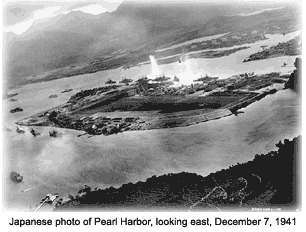 The increasingly powerful advances of the Japanese during the months following the Pearl Harbor Attack were reason for serious concern to the United States government. The morale of the American people and armed services was low — the U.S. needed a victory, and soon.
American losses at Pearl Harbor and the Philippine Bataan Peninsula ultimately sparked a tactically irrelevant, but priceless morale mission to bombard Tokyo. At the beginning of April 1942, as the Japanese were completing their conquest of the Philippines, U.S. forces were ready to launch a raid on Tokyo.
Insight
President Franklin D. Roosevelt ordered an air strike on Tokyo as early as December 1941. However, his military advisers were not able to conjure up a feasible mission to carry out his order. There were no Allied airfields close enough to the Japanese home islands for heavy Army Air Force bombers to launch an attack.
The first piece of the puzzle fell into place in the second week of January 1942. Captain Francis Lowe, attached to Admiral Ernest King's staff in Washington, paid a visit to Norfolk, Virginia, to inspect the new carrier U.S.S. Hornet CV-8. At a nearby airfield, he noticed the birds-eye outer edges of a carrier painted on the tarmac, which inspired Lowe to pursue the possibility of launching bombers from an aircraft carrier.
The increasingly powerful advances of the Japanese during the months following the Pearl Harbor Attack were reason for serious concern to the United States government. The morale of the American people and armed services was low — the U.S. needed a victory, and soon.
American losses at Pearl Harbor and the Philippine Bataan Peninsula ultimately sparked a tactically irrelevant, but priceless morale mission to bombard Tokyo. At the beginning of April 1942, as the Japanese were completing their conquest of the Philippines, U.S. forces were ready to launch a raid on Tokyo.
Insight
President Franklin D. Roosevelt ordered an air strike on Tokyo as early as December 1941. However, his military advisers were not able to conjure up a feasible mission to carry out his order. There were no Allied airfields close enough to the Japanese home islands for heavy Army Air Force bombers to launch an attack.
The first piece of the puzzle fell into place in the second week of January 1942. Captain Francis Lowe, attached to Admiral Ernest King's staff in Washington, paid a visit to Norfolk, Virginia, to inspect the new carrier U.S.S. Hornet CV-8. At a nearby airfield, he noticed the birds-eye outer edges of a carrier painted on the tarmac, which inspired Lowe to pursue the possibility of launching bombers from an aircraft carrier.
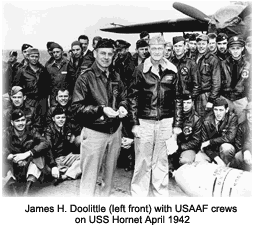 Right man for the job
Since medium bombers were in the U.S. Army Air Force, the project was then passed to it, and General Henry "Hap" Arnold wisely appointed Lt. Colonel Jimmy Doolittle as mission commander. Doolittle would soon prove to be the right man for the technically challenging mission.
Doolittle wasted no time in selecting the correct aircraft for the mission. With a doctorate from M.I.T., Jimmy Doolittle had to find a bomber capable of taking off from the short runway of an aircraft carrier, carrying a ton of bombs, and flying no fewer than 2,400 nautical miles. He selected the twin-engine B-25B Mitchell. Sixteen bombers would participate in the mission.
The plan
The bombers had to be stripped of any non-essential metal, to make room for extra fuel and reduce the overall weight. With the engines optimized for fuel efficiency, 200-gallon rubber tanks were installed in the bomb compartment, another 160-gallon fuel tank was put in the crew corridor, and a 60-gallon fuel tank replaced the machine guns in the ventral turret. Lastly, 10 five-gallon tanks were taken, to be manually added in flight.
The plan called for Doolittle to depart first, to attack Tokyo at dusk. The fire from his bombs would help the following fliers with their navigation. The remaining 15 bombers, in five formations of three, were given prime industrial and energy targets throughout Tokyo, and also in nearby Nagoyo, Osaka, and Kobe. With a proposed launch distance of 400 miles from Japan, and after dropping their payload, the 16 B-25s would head to a secure location in China under the protective cover of night.
After much-needed technical training, Doolittle and his 79 special mission volunteers braced for the flight.
Right man for the job
Since medium bombers were in the U.S. Army Air Force, the project was then passed to it, and General Henry "Hap" Arnold wisely appointed Lt. Colonel Jimmy Doolittle as mission commander. Doolittle would soon prove to be the right man for the technically challenging mission.
Doolittle wasted no time in selecting the correct aircraft for the mission. With a doctorate from M.I.T., Jimmy Doolittle had to find a bomber capable of taking off from the short runway of an aircraft carrier, carrying a ton of bombs, and flying no fewer than 2,400 nautical miles. He selected the twin-engine B-25B Mitchell. Sixteen bombers would participate in the mission.
The plan
The bombers had to be stripped of any non-essential metal, to make room for extra fuel and reduce the overall weight. With the engines optimized for fuel efficiency, 200-gallon rubber tanks were installed in the bomb compartment, another 160-gallon fuel tank was put in the crew corridor, and a 60-gallon fuel tank replaced the machine guns in the ventral turret. Lastly, 10 five-gallon tanks were taken, to be manually added in flight.
The plan called for Doolittle to depart first, to attack Tokyo at dusk. The fire from his bombs would help the following fliers with their navigation. The remaining 15 bombers, in five formations of three, were given prime industrial and energy targets throughout Tokyo, and also in nearby Nagoyo, Osaka, and Kobe. With a proposed launch distance of 400 miles from Japan, and after dropping their payload, the 16 B-25s would head to a secure location in China under the protective cover of night.
After much-needed technical training, Doolittle and his 79 special mission volunteers braced for the flight.
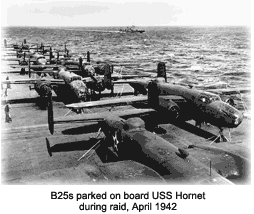 Change of plan
The Hornet departed from San Francisco on April 2, with its oversized fleet of 16 B-25 bombers parked on the rear flight deck. The Hornet soon met up with the U.S.S. Enterprise north of Midway, on April 12th. Admiral William F. "Bull" Halsey, commander of the Pacific Fleet, preceded Task Force 16 westward. On April 17th, the carriers and their four escorting cruisers would leave their accompanying destroyer canopy and tankers behind to commence a high-speed race toward the Japanese home islands.
Takeoff was scheduled for April 19th in the afternoon, but on April 18th, 1942, at dawn, the task force was detected by a Japanese patrol boat — some 600 miles from the islands. The patrol boat, full of civilians, was quickly incinerated by one of the cruisers. However, it was correctly assumed that the Americans' presence had already been reported to Tokyo — a report which was ignored by disbelieving Japanese officials.
Change of plan
The Hornet departed from San Francisco on April 2, with its oversized fleet of 16 B-25 bombers parked on the rear flight deck. The Hornet soon met up with the U.S.S. Enterprise north of Midway, on April 12th. Admiral William F. "Bull" Halsey, commander of the Pacific Fleet, preceded Task Force 16 westward. On April 17th, the carriers and their four escorting cruisers would leave their accompanying destroyer canopy and tankers behind to commence a high-speed race toward the Japanese home islands.
Takeoff was scheduled for April 19th in the afternoon, but on April 18th, 1942, at dawn, the task force was detected by a Japanese patrol boat — some 600 miles from the islands. The patrol boat, full of civilians, was quickly incinerated by one of the cruisers. However, it was correctly assumed that the Americans' presence had already been reported to Tokyo — a report which was ignored by disbelieving Japanese officials.
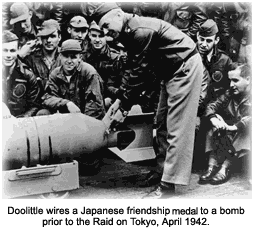 Early detection posed a major difficulty. On the one hand, the carriers were still more than 200 miles from their calculated takeoff point, and fuel supplies were already a problem. On the other hand, Admiral Halsey knew that the group might be attacked by Japanese carrier aircraft at any time. At 8 a.m. he ordered Doolittle's raiders to take off.
Doolittle's raid
The morning of April 18th, 1942, dawned upon a blustery and unrelenting sea. With 30-foot swells, zero degrees, and a typhoon-force wind buffeting the Hornet, the men prepared for an uncertain lift-off. Doolittle called all of his men onto the deck and said, "If there's any of you who don't want to go, just tell me. Because the chances of you making it back are pretty slim." Nobody batted an eye.
The crews rushed to their bombers. The Hornet turned into the strong wind. Engines came alive. Doolittle released the brakes, and after a short run (with room to spare), launched his aircraft from the "cork-bobbing" carrier. All 15 bombers successfully followed, and then the carrier task force quickly turned back for Pearl Harbor.
Early detection posed a major difficulty. On the one hand, the carriers were still more than 200 miles from their calculated takeoff point, and fuel supplies were already a problem. On the other hand, Admiral Halsey knew that the group might be attacked by Japanese carrier aircraft at any time. At 8 a.m. he ordered Doolittle's raiders to take off.
Doolittle's raid
The morning of April 18th, 1942, dawned upon a blustery and unrelenting sea. With 30-foot swells, zero degrees, and a typhoon-force wind buffeting the Hornet, the men prepared for an uncertain lift-off. Doolittle called all of his men onto the deck and said, "If there's any of you who don't want to go, just tell me. Because the chances of you making it back are pretty slim." Nobody batted an eye.
The crews rushed to their bombers. The Hornet turned into the strong wind. Engines came alive. Doolittle released the brakes, and after a short run (with room to spare), launched his aircraft from the "cork-bobbing" carrier. All 15 bombers successfully followed, and then the carrier task force quickly turned back for Pearl Harbor.
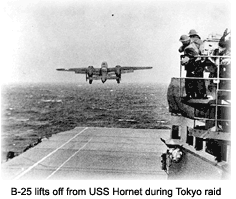 At 12:30 p.m., Doolittle pulled up to 1,200 feet over Tokyo and released four magnesium fire bombs in rapid succession. The rest of "Jimmy's Raiders" followed suit, delivering a "hello" to Tokyo, Yokahama, Kawasaki, Nagoya and Kobe. All bombers escaped Japan's airspace without so much as a scratch.
After releasing their terror over Japanese soil, they headed eastward for sanctuary. Because of punishing China Sea winds and a premature takeoff, the bombers did not have enough fuel to reach their original landing objectives.
At 12:30 p.m., Doolittle pulled up to 1,200 feet over Tokyo and released four magnesium fire bombs in rapid succession. The rest of "Jimmy's Raiders" followed suit, delivering a "hello" to Tokyo, Yokahama, Kawasaki, Nagoya and Kobe. All bombers escaped Japan's airspace without so much as a scratch.
After releasing their terror over Japanese soil, they headed eastward for sanctuary. Because of punishing China Sea winds and a premature takeoff, the bombers did not have enough fuel to reach their original landing objectives.
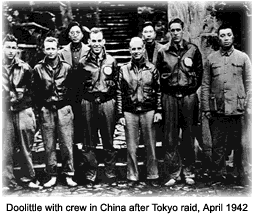 One of the bombers landed in Vladivostok in the Soviet Union, where it was promptly seized, while the other 15 were lost over China. Of the 80 crew members launched on the perilous mission, the five who arrived in the USSR were interned, and 62 of the others (including Doolittle) were saved by the Chinese. Five died while evacuating their plane — and eight were captured by the furious Japanese (of whom three were executed as war criminals, and one left to starve in prison). The remaining four were released.
Aftermath
The raid on Tokyo, like the attack on Pearl Harbor, exerted a profound impact on the conduct of the Pacific war. Colonel Doolittle's command suffered a 100-percent loss of aircraft and a 22-percent loss of crew members. However, the morale boost that followed for fellow soldiers and the general public helped America and its allies gain important momentum in the Pacific Theater.
One of the bombers landed in Vladivostok in the Soviet Union, where it was promptly seized, while the other 15 were lost over China. Of the 80 crew members launched on the perilous mission, the five who arrived in the USSR were interned, and 62 of the others (including Doolittle) were saved by the Chinese. Five died while evacuating their plane — and eight were captured by the furious Japanese (of whom three were executed as war criminals, and one left to starve in prison). The remaining four were released.
Aftermath
The raid on Tokyo, like the attack on Pearl Harbor, exerted a profound impact on the conduct of the Pacific war. Colonel Doolittle's command suffered a 100-percent loss of aircraft and a 22-percent loss of crew members. However, the morale boost that followed for fellow soldiers and the general public helped America and its allies gain important momentum in the Pacific Theater.
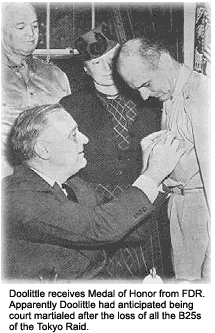 The Japanese itemized the actual damage as:
The Japanese itemized the actual damage as:
Fifty dead, 252 wounded, 90 buildings damaged or destroyed, including the Japanese Diesel Manufacturing Company, the Japanese Steel Corporation's Factory Number one, the Mitsubishi Heavy Industrial Corporation, the Communication Ministry's transformer station, the National Hemp and Dressing Company, the Yokohama Manufacturing Company warehouse, the Nagoya Aircraft Factory, an army arsenal, a naval laboratory, an airfield, an ammunitions dump, nine electric power buildings, six gas tanks, a garment factory, a food storage warehouse, a gas company, two miscellaneous factories, six wards of the Nagoya Second Temporary Army Hospital, six elementary or secondary schools, and innumerable nonmilitary residences.The month of May 1942, following the Tokyo raid, proved to be devastating for the Chinese. The Japanese launched operation Sei-Go, with two objectives: to secure Chinese airfields, and punish villagers accused of assisting the downed airmen. Tens of thousands — perhaps as many as 250,000 Chinese civilians — were slain in the Chekiang and Kiangsu provinces.